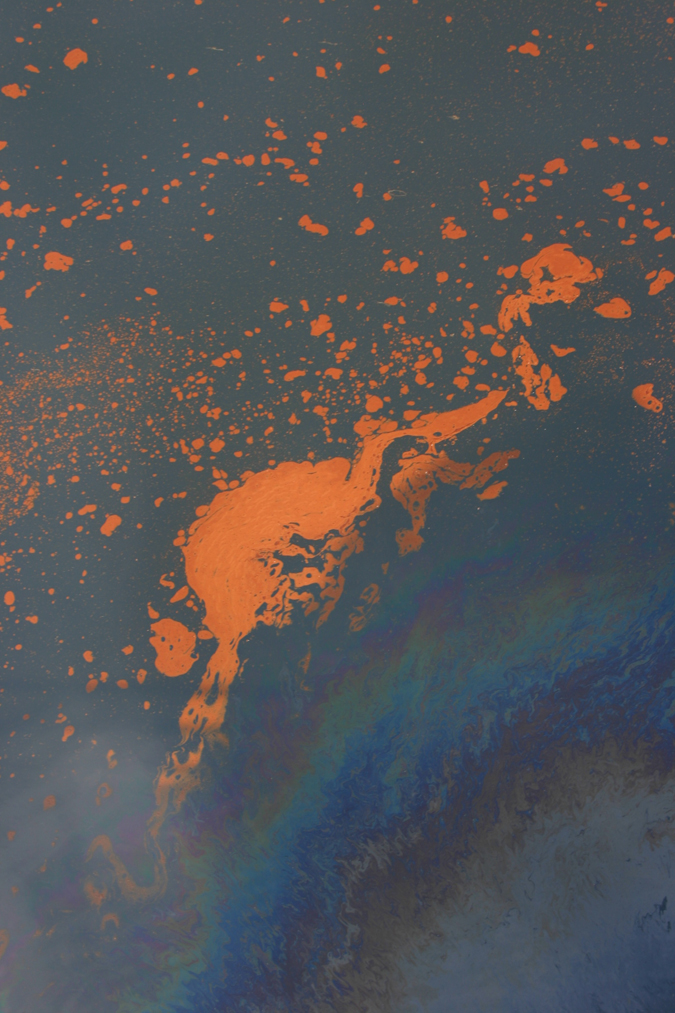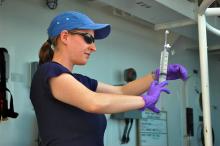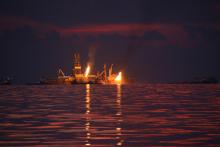
Scientists Reveal How Natural Gas and Temperature Controlled Bacterial Response to Deepwater Horizon Oil Spill


In a new study, UC Santa Barbara scientists explain how they used DNA to identify microbes present in the Gulf of Mexico following the Deepwater Horizon oil spill, and how they identified the microbes responsible for consuming the large amount of natural gas present immediately after the spill. They also explain how water temperature played a key role in the way bacteria reacted to the spill.
The results of their research are published in the Proceedings of the National Academy of Sciences. The study was led by David Valentine, a geochemist and professor of earth science at UCSB, and Molly Redmond, a postdoctoral scholar in Valentine's laboratory. The research was supported by the National Science Foundation and the Department of Energy.
The Deepwater Horizon oil spill was unique, according to the scientists, because it happened at such great depth and contained so much natural gas –– predominantly methane, ethane, and propane. Those factors influenced the way bacteria responded to the spill. In earlier studies, Valentine, Redmond, and their colleagues showed that ethane and propane were the major hydrocarbon compounds being consumed in June 2010, two months after the start of the April spill. By September 2010, the scientists found that these gases and all of the methane had been consumed.
In May and June of 2010, the scientists found that bacterial communities in the Deepwater Horizon submerged plume were dominated by just a few types –– Oceanospirillales, Colwellia, and Cycloclasticus –– and were very different from control samples without large concentrations of oil or gas, and also from the communities in surface oil slicks collected at the same time.
"It's much warmer at the surface than in the deep water –– around 80 degrees (Fahrenheit) versus 40 degrees, which is pretty close to the temperature in your refrigerator," said Redmond, the study's lead author. "There was very little natural gas in the surface samples, suggesting that both temperature and natural gas could be important in determining which bacteria bloomed after the spill. The bacteria we saw in the deep-water samples in May and June were related to types of psychrophilic, or cold-loving bacteria. Most bacteria grow more slowly at cooler temperatures –– that's why we keep our food in the refrigerator. But psychrophilic bacteria actually grow faster at cold temperatures than they would at room temperature."
To provide additional evidence of the importance of temperature, the scientists added oil to water from the Gulf and incubated it at 40 degrees and at room temperature (about 70 degrees), and looked at which bacteria grew at the different temperatures. In the 40-degree samples, Colwellia were most abundant, but were only found in low numbers in the room temperature samples, suggesting that these particular bacteria have an advantage in cold water.
"To figure out which bacteria were consuming methane, ethane, and propane, we used a technique called stable isotope probing, where we incubated fresh seawater samples from the Gulf with isotopically labeled methane, ethane, or propane," Redmond said. "The bacteria that grew as they consumed the methane, ethane, or propane converted the isotopically labeled gases into biomass, including their DNA. By sequencing the labeled DNA, we were able to identify the bacteria that had consumed the methane, ethane, or propane. The bacteria that consumed the ethane and propane were the same Colwellia that we saw at high abundance in the environmental samples from May and June, when ethane and propane consumption rates were high, and that were abundant when we incubated oil at 40 degrees, but not at room temperature."
This suggests that the Colwellia were abundant because they grow well at low temperatures and because they could consume ethane and propane, which were very abundant during the spill, the researchers said. The bacteria that consumed methane were a group of bacteria called Methylococcaceae –– the same bacteria that were abundant in September after the methane had been consumed, suggesting that they were, in fact, important in consuming methane.
"The ability of oil-eating bacteria to also grow with natural gas as their foodstuff is important, because these bacteria may have grown to high numbers by eating the more-abundant gas, and then turned their attention to other components of the oil," said Valentine. "With this work, we have revealed some of the relationships between hydrocarbons released from Deepwater Horizon and the bacteria that responded. But numerous questions remain as to how the bacteria interacted with one another, and how this ecology impacted the fate of the released oil."
† Top image: Molly Redmond collects water samples for methane analysis aboard the NOAA Ship Pisces in September 2010.
Credit: Elizabeth Crapo/NOAA
†† Middle image: Flaring of captured gas (left) and oil (right) at the Deepwater Horizon spill site in June 2010.
Credit: David L. Valentine
††† Bottom image: An oil slick at the sea surface containing highly weathered orange-colored oil and a fresh rainbow-colored sheen, in June 2010.
Credit:
David L. Valentine
Related Links



